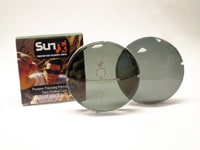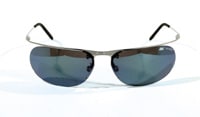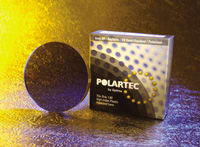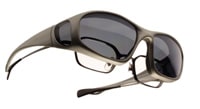The
Polarized Push
With sunwear sales slackening, polarized is
definitely the brightest star in the category
By Joseph L. Bruneni
Polarized sunglasses currently represent the fastest growing category for both over-the-counter plano sunwear and prescription sunlenses. Much of the growth and consumer interest in this action-type lens has come about in the last few years. This is surprising in view of the fact that the first polarized sunglasses were introduced to consumers more than 70 years ago. Despite slow growth, this lens has become a primary lens-of-choice in plano sunwear. Visit any sporting goods store or sunglass mall store and notice how many of the better quality sunglass models feature polarized lenses.
|
|
|
|
The Cyclone from Panoptx features a polarized copper lens designed for snow and water sports |
|
This trend to polarized lenses is now influencing the prescription end of the sunglass market as well. The following information will review why this sunglass category languished and examine why polarized lenses have become the "belle of the ball."
The first polarized sunglasses were non-prescription and produced by American Optical. They hit the market in 1936. A few years later they became available in prescription form, and polarized sunglasses have been part of the sunglass market ever since. From the very beginning, polarized lenses were well received. Consumers loved the way these lenses accomplished their magic. Usually a simple demonstration to a consumer was all it took to produce a sale.
EARLY LIMITATIONS
Over time, however, several factors limited sales.
|
|
|
|
SunRx polycarbonate polarized lenses from Vision-Ease are created using a patented production process that reduces glare and increases clarity |
Separation. The first was the fact that polarized lenses (both glass and later plastic) had a distressing tendency to separate or delaminate. The lenses were created by laminating two thin glass or plastic wafers together with a plastic polarized film in the center. Separation would first show up as a small opaque whitish patch at one edge of the lens, sometimes caused by stress on the frame or lenses but more often simply from humidity or changes in temperature. Within days, the patch would grow until the lenses were unusable.
Material. Another quality issue was common during the first 40 years when most polarized lenses were glass. Polarized glass lenses consisted of two very thin glass wafers with film laminated in the center. They did not require tempering or drop ball testing, and it took only slight pressure on the lens to crack one or both wafers. The broken pieces were held together by the lamination but no one wanted to view the world through cracked lenses.
Cost. A more limiting factor was cost. The expensive manufacturing process was reflected in a rather costly fee to consumers. The price difference between conventional sunglasses and polarized sunglasses was substantial at a time when eyewear was relatively inexpensive.
|
|
|
|
Bollé's Valorium frame is available with polarized lenses in a variety of colors |
|
Fortunately, both the quality issue and price concerns have been overcome. Today's polarized lenses are no longer laminated, so most dispensers today have never seen a delaminated polarized lens. In regard to cost, rapid advancements in lens technology have substantially raised the prices of eyewear, so polarized lenses are not such a major cost factor.
POLARIZED LENSES DIFFER
Since the very earliest days in optical history, lenses made from colored transparent materials have been used to protect eyes from bright sunlight. The Chinese were making sunglasses with lenses made from colored quartz more than 400 years ago. It's interesting to note that the Chinese were mostly interested in the medicinal benefits of their sunglasses. They wore their colored lenses continuously, not just on sunny days, because they believed viewing the world through colored lenses would cure a variety of medical conditions.
In later centuries, as glass became the material-of-choice for eyeglasses, it became relatively easy for manufacturers to add color to raw glass for sunlenses. The development of plastic lenses made tinting sunlenses even easier.
The primary function of sunlenses is to reduce the amount of light entering the eye. The eyecare professions found there were advantages to certain colors like gray, green, and brown. But the primary goal was to reduce the amount of light entering the eyes, and most of the sunlenses worked relatively well.
All sunlenses had one shortcoming, however: The way they dealt with glare, or rather, how they failed to deal effectively with glare.
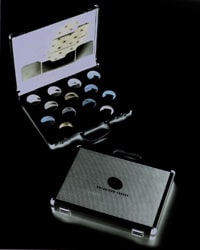
|
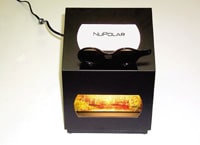
|
| The Polarized Lens Sample Briefcase from KBco | Younger Optics' demonstration unit shows the dramatic impact of polarization |
DEFINING GLARE
Dictionaries define the natural phenomenon of glare as "a harsh, bright dazzling light." Glare can come from an intense light source such as the headlight of an automobile or spotlight, but is commonly associated with sunlight reflecting off of bright surfaces.
The outdoor world is illuminated by light coming from overhead--that is, from the sun. When overhead light strikes a bright and shiny horizontal surface, it is reflected and aimed upward at an oblique angle--often into a viewer's eyes.
|
|
|
| Optima is launching POLARTEC™, the only 1.60 aspheric polarized lens, this month | SunClear polarized lenses from Polycore Optical filter out the light that causes glare |
This common phenomenon intensifies the amount of sunlight entering the eyes and creates what we have come to know as glare. It is produced in a variety of ways during daylight hours--sunlight reflected from road surfaces, automobile hoods, water, snow, ice, or virtually any shiny surface. Glare can also be produced by fog, rain, haze, and smog because light is reflected from the individual particles making up the haze or fog. The primary visual concern with glare is that added light from reflections intensifies the amount of light entering a viewer's eyes.
|
|
|
|
Live Xtreme model X902G from Live Eyewear with gray polarized polycarbonate lenses |
Glare can present significant hazards to vision. The Dictionary of Ophthalmic Optics defines the visual effects of glare this way: "Relatively bright light entering the eye creating dazzle, discomfort, or visual impairment. Within the visual field, a brighter light or greater illumination level than that to which the eyes are adapted; the contrast-lowering effect of stray light may cause temporary loss of visual performance or acuity, annoyance, or blindness."
Conventional sunlenses are not efficient at handling glare. Looking directly at reflected glare is not much different from gazing directly into the sun, and blocking a brilliant light source like this requires an extremely dark sunlens.
Think of the lenses commonly suggested for use in observing an eclipse of the sun. "Eclipse viewers" are nearly opaque, almost like a welding goggle.
Conventional sunlenses reduce sunlight from around 100 percent down to a pleasant 15 to 20 percent. Glare observed through normal sunlenses is reduced by a similar factor, but, because of the glare's greater intensity, the reflected light still substantially exceeds the eye's comfort zone. Simply put, conventional sunlenses are efficient at providing comfortable vision on bright sunny days, but they fail significantly at bringing reflected glare down to acceptable levels for visual comfort.
|
Dispensing Polarized Sunwear |
|
Polarized suppliers have produced some very efficient demonstrator kits that show patients how these specialty sun lenses block glare. Demo Kits. Most dispensers who have set up polarized demo kits in their dispensaries report sales of polarized sunwear increased dramatically once they were able to demonstrate how these lenses do their work. Plano sunwear. Another positive way to demonstrate polarized lenses is to have an attractive display of plano polarized sunwear. This display is a way to visibly emphasize that top-of-the-line sunwear uses polarized lenses. Rotate lenses. Such a display also makes it possible to provide another effective demonstration of how polarized lenses do their work. Take two pairs of polarized sunglasses and position one in front of the other. Rotate one frame to change the lens orientation and show how this totally blocks out light. It's an entertaining demonstration and always impresses patients who haven't seen it before. Handling tips. Polarized lenses require no special care for drilling, beveling or grooving. They can be tinted like other plastic lenses as long as they are not over-heated. In edging, be sure to properly align the polarizing filter. The lenses come with markings to indicate the 180° line used for edging the lenses. Make sure beveled lenses are sized for a snug fit and not overly tight. Polarized lenses can be mirror coated or AR coated. |
|
POLARIZED TECHNOLOGY
Here is the major distinction that differentiates polarized lenses from conventional sunlenses: Polarized lenses have an uncanny ability to block reflected light. They are able to selectively block sunlight reflected from horizontal surfaces (commonly defined as glare).
If there is no glare, polarized lenses function like conventional sunlenses. But when sunlight is reflected from horizontal surfaces, the polarizing filter steps into action and functions like a Venetian blind, blocking the light rays.
It was Edwin Land (inventor of Polaroid Instant Cameras) who in 1935 discovered a way to create a man-made polarizing filter. The filter consists of a thin plastic sheet made up of uniformly aligned needle-shaped crystals. The parallel rows of crystals permit light rays oriented in only one direction to pass through while blocking light in the opposite meridian--like a Venetian blind.
For sunglasses, the film is oriented in the lens so that horizontal light rays (reflecting from horizontal surfaces) are blocked. During manufacturing, the thin polarizing film is suspended in the mold just behind the front surface. When the lens is cast, the film becomes an integral part of it. This "in mold" process replaces lamination and eliminates the tendencies of polarized lenses to separate or delaminate.
Polarizing filters are widely used for a variety of purposes. Many digital instruments use LCD (liquid crystal display) technology. Digital instruments are polarized and can be found in digital watches, ATMs, gas pumps, automobile instrument panels, and computers.
It's not uncommon to be unable to read the numbers on a gas pump when wearing polarized glasses--the polarizing filter in the pump gauge is lined up so polarized sunglasses block the numbers. An observer can prove this by merely tilting his or her head to a 45 degree angle and the numbers will appear. Polarized instrument manufacturers are aware of the growing use of polarized sunglasses and are changing how they orient the film in their gauges. Laptop computer makers, for example, have lined up the polarizing filter in LCD screens so there is no visual interference when working outdoors on a laptop while wearing polarized sunglasses.
While understanding technology is important, one of the best features of these premium sunlenses is that dispensing them requires no special skills. The most important thing is knowing how to explain and demonstrate them (see sidebar). And, according to many eyecare professionals, when demonstrated, the lenses nearly sell themselves.
|
New In Polarized Lenses |
There have been a number of new developments in polarized lenses, evidence of the growing importance of these premium sunlenses. The following information highlights some of the new polarized technology that has been introduced for prescription use during the past year.
Additional information on polarized lenses can be found at: KBco:
www.kbco.net |





